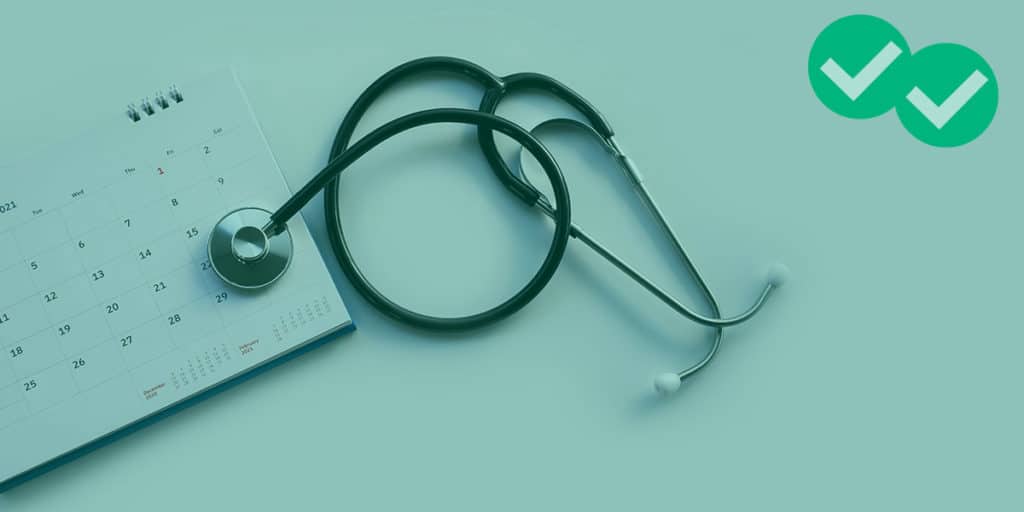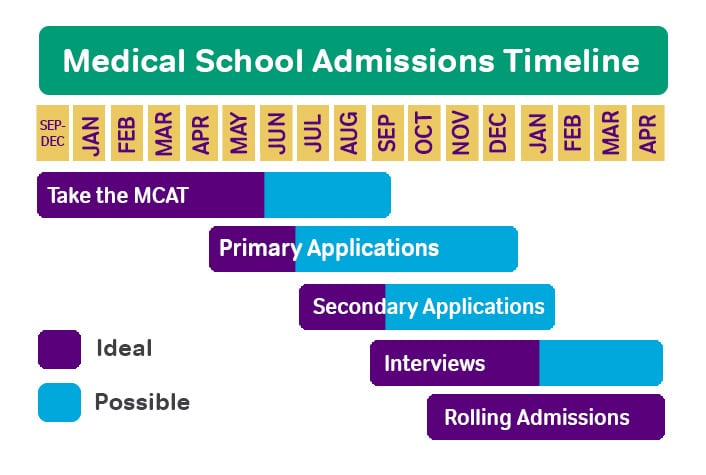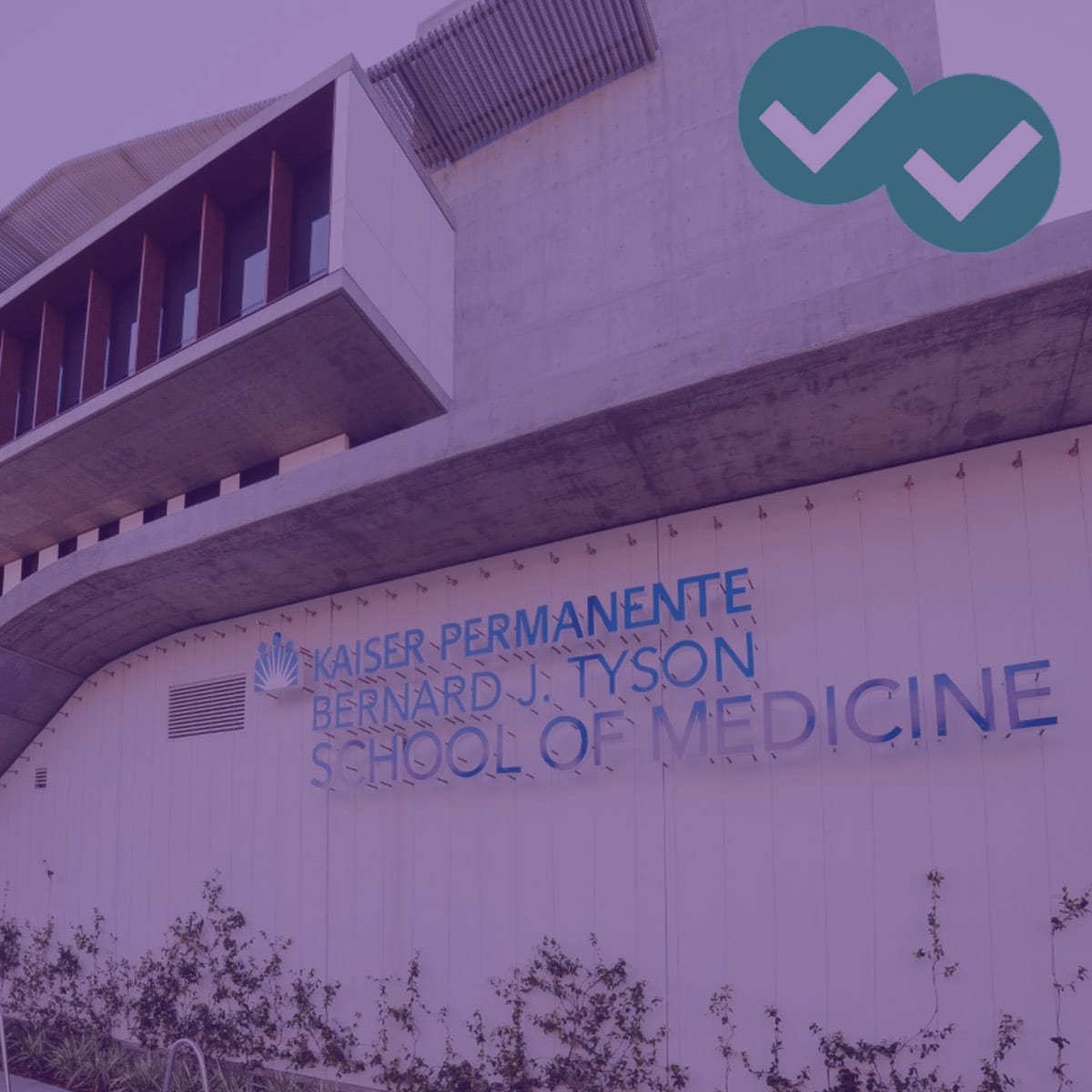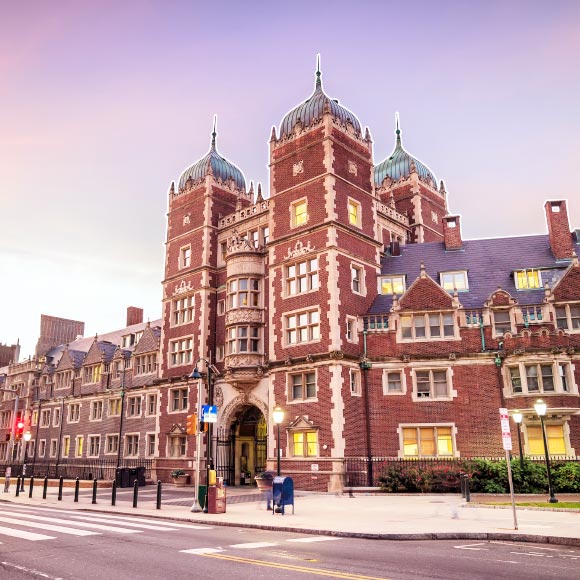 Applying to medical school is a big decision. The process is long and can easily last over a year, while the med school application can be tricky. So what do you need to get into med school? This post will summarize the medical school applications process and what you can do to put yourself in a position to succeed.
Applying to medical school is a big decision. The process is long and can easily last over a year, while the med school application can be tricky. So what do you need to get into med school? This post will summarize the medical school applications process and what you can do to put yourself in a position to succeed.
Before we dive into anything else, here’s a quick glance at what you’ll need for your medical school applications.

Table of Contents
- Medical School Application Timeline: Preliminary Work
- The Three Kinds of Medical School Applications
- Secondary Applications: How to Prepare
- Interviews
- Final Tips for Medical School Applications
Medical School Application Timeline: Preliminary Work
The process really starts during your years in college. So how do you build the foundation for successful med school applications?
- Do your best in all your coursework and build relationships with professors who can write you letters of recommendation.
- Study hard for the Medical College Admission Test (MCAT exam) to get the best score that you can on your test date.
- Start thinking about your personal statement early and have others look at drafts for you.
- Gather materials early. Ideally, you will have your letters of recommendation, MCAT score, and personal statement ready to go by June the year before you plan to start medical school. June is when the AMCAS system opens, and it is a great idea to submit your application as early as possible.
- Keep an eye out for secondary applications. After submitting your application, schools will begin sending out secondary applications. These are essays schools require you to write in addition to your personal statement and are often school specific (and expensive when it comes to application fees!).
The Three Kinds of Medical School Applications
While you may have heard of the AMCAS application, which is the most popular, there are other med school application services you may use, as well, depending on where you and what type of DO/MD programs you’re applying to–the AACOMAS application and the TMDSAS application. Take a look!
| American Medical College Application Service (AMCAS) | Texas Medical & Dental Schools Application Service (TMDSAS) | American Association of Colleges of Osteopathic Medicine Application Service (AACOMAS) | |
|---|---|---|---|
| Who? | Applicants to most U.S. medical schools | Texan applicants to medical, dental, and veterinary schools | Applicants to most DO programs/osteopathic schools in the U.S. |
| When? |
|
|
NB: Programs have varying deadlines, so confirm with each school individually. |
| How much? | $160 for the first program, then $38 for each one after that | $150, no matter how many programs you apply to | $195 for the first program, then $40 for each one after that |
You’ll notice that the medical school application timeline begins early: you should start your application for med school as early as May in the year you’re applying. However, you won’t be required to submit it until August at the earliest—but don’t let this be an excuse to put things off until the last moment in the application cycle! Getting materials together early will ensure you fulfill all of the medical school admission requirements without putting yourself under too much pressure. The whole process can take several months to complete, depending on the specific deadlines you’re targeting.
Med School Application Materials
No matter which service you use, there are still a few things that you’ll always need for your application. Things that you’ll need in your packet for med school applications include:
- MCAT scores
- Personal statement
- Your official transcripts from your bachelor’s degree
- Letters of recommendation
AMCAS Activities and Experiences: Tips to Take Advantage of the Section
The AMCAS (American Medical College Application Service) application includes an experiences section. If you remember your college application days, think of it as an extended Common App activities section. You’ll have 15 boxes to include relevant work, research, internship, volunteer, or extracurricular activities. Take advantage of all that this section has to offer!
- Choose your most relevant or important activities.
- Group relevant activities together under a catchall description heading.
- Don’t include “filler” activities.
- Take advantage of the description section. These descriptions are a great way to provide in-depth insight into the effect an activity had on your medical school path.
- Display your passions.
- Be direct! Strong language and concrete stories are key in displaying the way an experience has impacted you!
Secondary Applications: How to Prepare
Processed AMCAS applications will be sent to medical schools starting June 30th, which means secondary applications will be rolling in as early as July. You can look through the AAMC Pre-Med calendar for a full list of important dates.
With most students applying to 20 or more med schools, it is important that you stay on top of the secondary application process. The art of writing med school secondaries takes time, but it should be your goal to complete and return each med school application within two weeks of receiving it. With such a short, recommended time frame, and with so many applications to complete, preparing ahead of time is extremely important. We have broken secondary prep down into 4 key steps for you:
- Prioritize Your School List
Click here for more information
When 20 secondaries come flying your way all in the same week, you need to make sure your priorities are set. Schools evaluate your secondary applications, in part, by how soon they receive them back after sending them out. A quicker turnaround is an indication of your interest in your school. That being said, you never want to compromise quality for quickness.
As you prioritize which schools you will address first, think through two key factors: 1) Your top-choice schools and 2) Your top-choice safety schools. You never want to neglect your “safety” schools in this process. At least 1-2 of them should get some preference when you’re preparing for your secondaries. The medical school admissions process is highly competitive, sometimes to the point where no school is a true safety. By all means, work extremely hard on your dream school’s secondary, but take a hard look at your medical school list, and make sure you’re giving yourself the best shot possible.
- Get Organized
Click here for more information
This is probably the most important step to take between turning in your AMCAS and waiting for secondaries. Get yourself organized. I always think spreadsheets are the best for big tasks like this one. Make a list of all of the schools you applied to, take down the secondary essay questions they ask for, and see if there are trends across schools.
Create a folder in your email or use Google Docs to keep everything in one spot. Use your calendar to set reminders for when you’re shooting to turn in a specific secondary. Remember: completing them within two weeks is the goal.
- Start Writing Now
Click here for more information
There are a few general types of questions that you will see again and again across different schools. It’s good to start writing frameworks for the most common ones rather than starting from scratch. For example, many different schools ask for a medical school “Diversity Essay,” which is essentially, “How are you different from other applicants, and how does that difference impact your ability to contribute in medical school and beyond?”
Other common questions are: Expand on your most meaningful experience; What sort of medicine do you hope to practice; Who is the most influential person in your life; Why this particular medical school?
- Do Your School Research
Click here for more information
The most common secondary essay is probably the “Why School X?” question. And if it doesn’t show up in your secondaries, it will definitely be asked during interviews. Making sure you understand the differences between schools is key. For example, Johns Hopkins is known for its focus on research and medical innovation, which you can clearly grasp just by reading the school’s admissions page. Not mentioning this in your secondary would be a missed opportunity. Similarly, if you’re applying to Texas schools and are interested in something like Alzheimer’s research, knowing that UT Southwestern houses the best research center in Texas is important. Do your school-specific research, and make notes of the differences between schools.
Interviews
Once schools receive your secondary applications, they will decide whether or not to offer you interview invitations. If you applied to a wide range of schools, a general rule of thumb is to expect interviews from about half the schools you applied to, and acceptances from about half of the schools you interviewed at.
Interviews generally go on from about September into February. Some schools have a rolling admissions decision, where they let you know some time after your interview whether you were admitted, rejected, or waitlisted. Other schools release all their decisions on a specific day, usually in March. April 30 is the day that your deposit is due, where you send a check to the school you wish to attend to hold your seat.
Approaching Your Interviews
What’s the best med school interview tip? You should truly be yourself. Seriously. Medical schools put a lot of emphasis on interviews because meeting you allows them to finally connect all the dots in your medical school application and get a full picture of who you are as a person. It’s your job to present yourself on your own terms.
How can you do this? Set yourself up for interview success. Every one of the AMCAS activities that you list is fair game in an interview. Make sure that you can talk at length about each and every one of your experiences—think about it as preparation for your medical school interviews! Make sure that you can speak knowledgeably and passionately about every single one of your AMCAS activities. Do not simply “check off the boxes.” Show schools that you are unique, passionate, driven, and fit to be a doctor.
![]()
Final Tips for Medical School Applications
That’s the medical school application timeline in a nutshell: primary application in by early May/June, secondary applications through the summer, interviews in the fall and winter (October, November, and December are likely months for this), admissions decisions in the spring! But beyond that, what do you need to keep in mind for your med school applications?
As you fill out your applications, remember to highlight the the major criteria that schools are looking for.
- First of all, point out your scholastic aptitude. Schools want to know if you can manage these type of course requirements by looking at your bachelor’s degree grades, particularly in prerequisites like organic chemistry, as well as your MCAT scores.
- Next, underline your critical exposure. Applying to medical school is ridiculously competitive, so it’s no wonder why it’s extremely important to admissions committees that applicants are truly committed to the field of medicine.
- Finally, don’t forget to point out what makes you unique on your med school application. Think of this as added value. Don’t be shy about that hobby or interest that you think has nothing to do with medicine—those things help to illustrate your humanism, which is an essential character trait for a future doctor.
Good luck!






